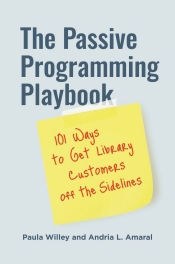Quick wins to boost engagement with passive programming

Passive programming can be a win on so many levels—cost, staff time, return on investment, a multi-generational grand slam—we could go on! According to the North Dakota State Library’s LibGuide, passive programs are “informal and interactive events that occur over the course of a predetermined day, week, or month. The beauty of passive programming is that everyone who walks through the door is encouraged to participate. There is no registration required, and the set-up can be as minimal or fancy as you decide.” The very passive nature of it means it is defined by how patrons engage with it. Passive programming invites opinions, creativity, and humor while creating community.
Ideas abound
Online ideas for passive programming at the library are abundant. Think Pinterest, Facebook (search "passive"), Reddit, and Imgur (the Imgur example focuses on passive programming for staff, but many can be adapted to the public) for starters. Poking around on these websites can spark creativity for what will suit your library best, but a few fun ideas to pique your interest:
- “Vision boards. Put out discarded magazines, scissors, glue sticks, and I like to use the cardboard inserts that come with book covers or in book boxes but have also used square cardstock.” (rojothecat, 2023, Reddit)
- Scavenger hunts can get patrons of all ages to explore the collection or space in new ways.
- Self-serve book recommendation forms or just Post-it notes to answer questions like “What’s a book that changed your life?” are a great way to encourage exploration of the collection and reader engagement.
- “Would you rather?” prompts answered with buttons in a jar or votes on a whiteboard are great ways to gauge interest and get to know your patrons better. Depending on where the display is, someone working the desk nearby might start a conversation with a patron who is answering the prompt and begin to build a relationship. Think of it as a great icebreaker tool.

The Passive Programming Playbook: 101 Ways to Get Library Customers Off the Sidelines (2021) is a helpful resource with field-tested ideas to reach diverse library patrons. The authors argue that passive programming is not a goal in and of itself but an ongoing first step toward building your audience and establishing connections. From there, you can build relationships and develop programs and services to meet your community’s needs. The authors elaborate that passive programming is great for the budget and terrific for showing high engagement numbers. It works well for people with busy or unpredictable schedules and for all abilities, and it is also perfect for teens who are less likely to want to participate in a program that feels more like school or has specific rules or schedules. Passive programming suits their need to have agency and voice. Which idea will you try first?
Subscribe
 Sign up to receive Crossroads, WebJunction's newsletter for library learning.
Sign up to receive Crossroads, WebJunction's newsletter for library learning.
